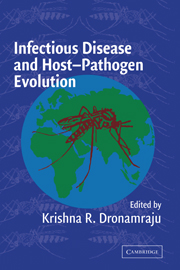Book contents
- Frontmatter
- Contents
- List of Contributors
- Introduction
- PART ONE J. B. S. HALDANE
- PART TWO MALARIAL PARASITES
- PART THREE OTHER PARASITES
- PART FOUR GENETIC AND EVOLUTIONARY CONSIDERATIONS
- 11 The Evolution of Pathogen Virulence in Response to Animal and Public Health Interventions
- 12 Infection and the Diversity of Regulatory DNA
- 13 Genetic Epidemiology of Infectious Diseases: The First Half-Century
- 14 The Impact of Human Genetic Diversity on the Transmission and Severity of Infectious Diseases
- 15 Evolution and the Etiology of Diabetes Mellitus
- 16 The Future of Human Evolution
- Index
- Plate Section
- References
14 - The Impact of Human Genetic Diversity on the Transmission and Severity of Infectious Diseases
Published online by Cambridge University Press: 10 August 2009
- Frontmatter
- Contents
- List of Contributors
- Introduction
- PART ONE J. B. S. HALDANE
- PART TWO MALARIAL PARASITES
- PART THREE OTHER PARASITES
- PART FOUR GENETIC AND EVOLUTIONARY CONSIDERATIONS
- 11 The Evolution of Pathogen Virulence in Response to Animal and Public Health Interventions
- 12 Infection and the Diversity of Regulatory DNA
- 13 Genetic Epidemiology of Infectious Diseases: The First Half-Century
- 14 The Impact of Human Genetic Diversity on the Transmission and Severity of Infectious Diseases
- 15 Evolution and the Etiology of Diabetes Mellitus
- 16 The Future of Human Evolution
- Index
- Plate Section
- References
Summary
THE INFECTIOUS THREAT
This opening century will appear as both “the golden age of genetics and the dark age of infectious diseases” (Tibayrenc, 2001a). On the battlefront of infectious diseases, the situation is more than just a concern, due to the threat of emerging and reemerging infectious diseases (ERID). In developing countries, infectious diseases still are the main demographic regulating factor. In particular, Africa is more than ever afflicted with sleeping sickness, malaria, bilharziosis, and other major parasitoses. The three “diseases of poverty,” namely malaria, tuberculosis, and AIDS, have become the top priority of the World Health Organization. The industrial world has not been spared. In France, 12,000 people die every year of nosocomial infections. In New York City, 25% of the Mycobacterium tuberculosis strains are resistant to antibiotics.
ENVIRONMENTAL AND BIOLOGICAL FACTORS
Transmission and severity of infectious diseases are the result of a complex interplay between environmental and biological (built-in) parameters. There is no doubt that environmental factors play a major role in the present resurgence of infectious diseases, through climatic changes, massive migrations, economic inequalities, and political instability. However, even in acting on these environmental factors, control is more efficient when sophisticated knowledge of the biology of the disease under survey is available. For example, in Latin America, Chagas disease is a parasitic disease caused by the flagellate Trypanosoma cruzi and transmitted by triatomine bugs (hematophagous tree bugs).
- Type
- Chapter
- Information
- Infectious Disease and Host-Pathogen Evolution , pp. 315 - 324Publisher: Cambridge University PressPrint publication year: 2004
References
- 2
- Cited by



